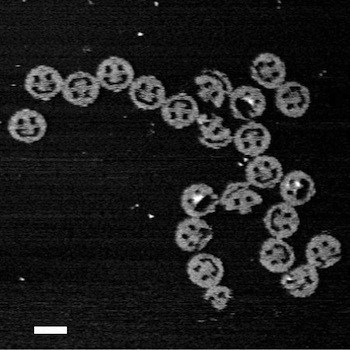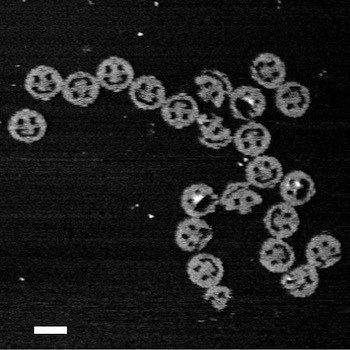
Since we frequently report progress in structural DNA nanotechnology made possible by the scaffolded DNA origami technique (most recently here), I cannot resist passing on these two news items that I stumbled upon at the Caltech web site, even though it is a day late for the first one, written by Lori Dajose: “Ten Years of DNA Origami“:
On March 16, 2006, Research Professor of Bioengineering, Computing and Mathematical Sciences, and Computation and Neural Systems Paul Rothemund (BS ’94) published a paper in Nature detailing his new method for folding DNA into shapes and patterns on the scale of a few nanometers. This marked a turning point in DNA nanotechnology, enabling precise control over designed molecular structures. Ten years later, the field has grown considerably. On March 14–16, 2016, the Division of Engineering and Applied Science will hold a symposium titled “Ten Years of DNA Origami” to honor Rothemund’s contribution to the field, to survey the spectrum of research it has inspired, and to take a look at what is to come.
“Think about DNA origami as a general-purpose pegboard for organizing nanometer-sized things,” Rothemund says. “Each DNA origami has 200 different attachment points, to which one can attach proteins, or tiny gold balls, or fluorescent molecules, or electrically conductive carbon nanotubes. There is no other way to juxtapose combinations of these elements into complex arrangements, and this is what researchers around the world, from biologists to physicists, are using DNA origami for. Biologists use DNA origami to position different protein enzymes next to each other, so that one enzyme can hand off its products to the next enzyme in a sort of nanoscale assembly line. Others are organizing electronic components in an attempt to make nanocircuits.”
The symposium was organized by Erik Winfree, professor of computer science, computation and neural systems, and bioengineering. “This amazing Caltech invention has had a remarkable impact in molecular nanotechnology research,” he says.
Talks will cover DNA nanotechnology, self-assembly and pattern formation, computational algorithms and software for origami design and analysis, applications in biology and biomedicine, applications in quantum physics, molecular motors and mechanical devices, biophysics and thermodynamics and kinetics, and more. The talks are open to the public, but attendees must first register online.
Continuing the celebration of Rothemund’s achievement “Paul Rothemund – DNA Origami: Folded DNA as a Building Material for Molecular Devices“:
Series:Earnest C. Watson Lecture Series
Wednesday, May 25, 2016, 8:00 pm, Beckman Auditorium
For 3.5 billion years, life has used DNA for information storage, to hold the blueprints of all living things. Over the last 35 years, humans have invented a new use for DNA—as a building material for molecular devices one hundred times smaller than the cell.
This talk will describe how complex DNA structures are designed via computer, synthesized using simple “kitchen chemistry,” and studied with atomic force microscopes a thousand times more powerful than standard light microscopes. We will explore how researchers around the world are applying DNA origami, from cancer-killing nanorobots, to exquisite light sources that will power quantum computers.
As an undergraduate at Caltech from 1990 to 1994, Paul W.K. Rothemund couldn’t decide whether to study biology, chemistry or computer science. Thus, he combined these interests and worked to build computers using DNA. After receiving a Ph.D. from USC in 2001, Rothemund returned to Caltech as a postdoctoral fellow, where he now remains as a research professor of Bioengineering, Computing and Mathematical Sciences, and Computation and Neural Systems. His primary interest is to transform biology into a discipline more like computer science or engineering, using techniques from programming and design. A complementary interest is to bring principles from biology, such as self-assembly, into the manufacture of technology, such as computers.
This is a free event; no tickets or reservations are required.
Paul Rothemund and Erik Winfree were the joint winners of the 2006 Foresight Institute Feynman Prize, in both the Theory and the Experimental categories, the only time that the same team has won both prizes the same year.
This month Nature Materials also commemorated the invention of DNA origami with an editorial titled “Returning to the fold“. After summarizing the enormous contributions this technology has made, the editorial also points out that (1) “a ‘killer application’ has yet to emerge from the many proof-of-concept studies that are currently underway”, and (2) that scale-up and cost considerations of DNA nanomaterials may be significant problems. But they conclude “continued efforts to understand the DNA folding process should lead to further improvements in structure control and product yield.” Certainly substantial problems remain, but from our view point the progress that we have cited provides reason to be optimistic that progress will continue.
—James Lewis, PhD

